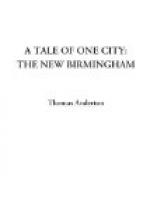Very possibly some of these would do the same if they had the chance, for your thorough-going Radical is often a curious creature. I remember once being at a London theatre with a friend of mine who was a desperate and despotic democrat, and who has been a leading light for years among our advanced Radicals. Now it so happened that on the evening of our visit the Prince of Wales was at the theatre we attended, and I was greatly amused to notice how interested my democratic friend was in watching the royal box. When the performance was nearing the end he amused me still more by suggesting that we should hurry out and watch the Prince drive off. “I do so like to see that sort of thing,” he added.
Mr. Chamberlain, however, is not the man to care what his foes or his old political friends think or say about him. Water on a duck’s back is, I fancy, an oppressive agony compared with the right honourable gentleman’s feelings when he hears or reads the condemnatory and abusive remarks of some of his former allies. If at any time he does perchance feel at all stung by any of the adverse criticisms he hears or reads, he takes care not to show that he is hurt.
Sparks will fly upwards, and Mr. Chamberlain has had his troubles, but he does not wear his heart on his sleeve, or carry his woes into the market place. I remember many years ago, under the stress of severe domestic affliction, he retired into private life for a considerable period, and it was said that during his self-imposed obscurity he sought occupation and solace in the study of Blue Books. Anyway, when he emerged into public life again he appeared as the author of a magazine article of an advanced political character, which seemed to shew that he had spent his solitude in studying and trying to solve some of the large political problems of the day.
In contemplating Mr. Chamberlain’s remarkable career and his high rise in the political world, I am tempted to wonder whether he would have built his large mansion near Birmingham if he could have foreseen the immediate future. When he made up his mind to erect his house at a great cost he perhaps scarcely dreamed he would so soon become a Cabinet Minister. Possibly he looked forward to being little more than a local member of Parliament—for he is not, I fancy, a dreamer of dreams—and felt he should like to pitch his tent near to his constituency.
Anyway he built his house at Moor Green, which he called “Highbury” after the name of the district in London where he was born. The house is well situated, though in some respects hardly built upon a site worthy of such a costly residence. It stands on a piece of rising ground, and commands a good prospect. In the front of it are the Lickey and Clent Hills some eight or ten miles away, but in the mid-distance is a manufacturing suburb with several tall chimneys which are obtrusively conspicuous, and which behave as factory chimneys generally do, scarcely improving the prospect or the atmosphere. These disadvantages were, I believe, pointed out to him before a brick was laid, but he had made up his mind, and when it is made up I fancy it is made up very much.




